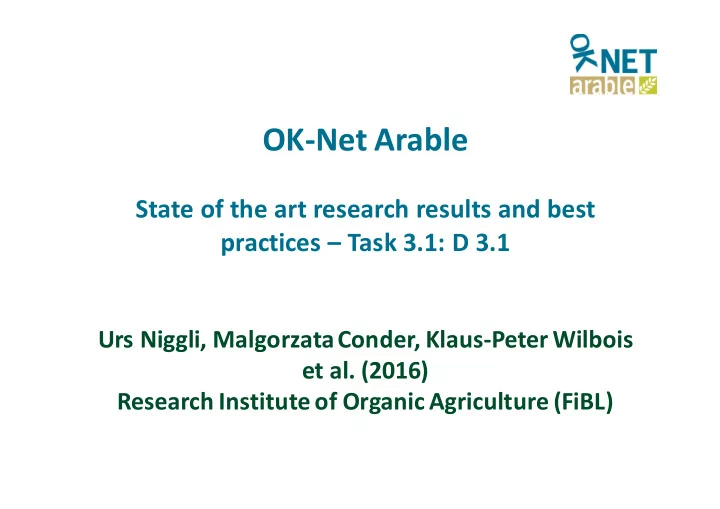

OK-Net Arable State of the art research results and best practices – Task 3.1: D 3.1 Urs Niggli, Malgorzata Conder, Klaus-Peter Wilbois et al. (2016) Research Institute of Organic Agriculture (FiBL)
Done • Identification of bottlenecks on organic practices based on the scientific and grey literature of 3 decades. • Intensive involvement of 30 scientists and farm advisors at FiBL and 5 key experts from UK, EE, IT, PO and GER. • Screening for solutions ready to become used by farmers. 2
Knowledge Synthesis • Meta-meta analysis. • Sound concept of transformation in different farming systems. • In-depth analysis crop by crop. • Identification of deficits and best solutions (ready, half-ready and up-coming). • Clear recommendations for the farmer innovation groups. • To be published by the end of January 2017 (Science or PNAS). 3
Outcome Transformation of Transformation of natural resources short-and long-acting anthropogenous measures Yield Synthetic fertilizers. Fossil fuels. Synthetic plant protection agents. Natural soil fertility Soil tillage. (rocks, relief, climate, living Aqui- organisms) red soil fertility Crop rotation. Biologically based and natural plant protection agents. Organic fertilizers, (green) manure. Eco- system Momentary natural influences services (weather, air quality, pests, pathogens)
Table 1: Yield gaps calculated by different meta-analyses (all crops under consideration) Study Yield gap Lotter 2003 -10 to -15% Seufert et al. 2012 -25% Stanhill 1990 -9% Ponisio et al. 2014 -19% de Ponti et al. 2012 -20% Badgley et al. 2007(developed countries) -9%
Crop-specific meta-analysis: Study Crop Yield gap Study Crop Yield gap Eltun 1996 Barley, oats, wheat -30% Seufert et al. 2012 Legumes NS Eltun et al. 2002 Barley, oats, wheat -35% Badgley et al. 2007 Legumes (developed countries) -18% Gabriel et al. 2013 Cereals -54% de Ponti et al. 2012 Legumes (global average) -12% Poutala et al. 1994 Cereals -25% Cavigelli et al. 2008 Soybean -19% Seufertet al. 2012 Cereals -26% Wortman et al. 2012 Soybean -17% Badgley et al. 2007 Cereals (developed countries) -7% Lotter et al. 2003 Soybean (legume rotation) +96% de Ponti et al. 2012 Cereals (global average) -21% Lotter et al. 2003 Soybean (manure-fertilized) +52% Cavigelli et al. 2008 Corn -24-41% Larsen et al. 2014 Corn -50% Poudel et al. 2002 Corn NS Study Crop Yield gap Wortman et al. 2012 Corn -13-33% Seufert et al. 2012 Oil crops NS Lotter et al. 2003 Corn (legume rotation) -62% Badgley et al. 2007 Oil crops (developed countries) -1% Lotter et al. 2003 Corn (manure-fertilized) +37% de Pontiet al. 2012 Oil crops (global average) -26% Wortman et al. 2012 Sorghum -16-27% Cavigelli et al. 2008 Wheat NS Ryan et al. 2004 Wheat -17-84% Study Crop Yield gap Wortman et al. 2012 Wheat -10-+10% Eltun et al. 2002 Potato -15% Arncken et al. 2012 Winter wheat -42% Mäder et al. 2002 Potato -36-42% Bilsborrow et al. 2013 Winter wheat -39% Badgley et al. 2007 Starchy roots (developed countries) -11% Hildermann et al. 2009 Winter wheat -38% de Ponti et al. 2012 Roots/tubers (global average) -26% Mäder et al. 2002 Winter wheat -10% Mäder et al. 2007 Winter wheat -14% Mayer et al. 2015 Winter wheat -36% Posner et al. 2008 Corn, soybean, wheat -10% 6
Grain yields of winter wheat varieties Yield increase per year Mäder, Fliessbach, Niggli (2002), Science 296 10 M: + 7.41 kg D2: + 1.74 kg 8 Grain yield (DM) [t ha -1 ] 6 D2 (org) D2 = Biodynamic M = Conventional M (conv) 4 stockless 2 Genetic gain be- 0 cause of manage- Probus CCP Antonius Titlis DI 9714 Caphorn Scaro Rouge de B. M. Calme 245 Sandomir ment restriction not sufficiently utilized! Organic breeds 1840 1926 2011 Isabelle Hildermann, 2010 (FiBL)
Key lever: Soil fertility • Soil organic matter: • C: soil depletion, compaction, erosion etc., nutrient insufficiency. • M: Reduced tillage, fungi based associations. • Legumes: • C: low variety choice and availability, lack of understanding of management and system level benefits. • M: Alternative crops, alternative techniques (intercropping, pre-cropping, crop species, variety choice, crop rotation, green manure, bio-effectors). ‒ Tools as VSA, Soil Quality Test Kit, Spade Diagnosis. C=Challenge M=Measure 8
Key lever: Nutrient management • Sewage sludge: • C: Not accepted by organic regulations, pollutants. • M: Precipitation processes for P-recycling. • Organic fertilizers: • C: Costly N and K sources from animal feathers, horns, hoofs, meat-bones, wool, hides. • M: Vinasse. • C: Phosphate rock and potassium sulphate for P and K insufficiently available and inefficient. C=Challenge M=Measure 9
Key lever: disease control • C: Multifactorial and variable → few direct measures available. • C: Development of PPP-compounds: long and costly. • M: Decision support systems (Öko-SIMPHYT). • M: variety choice through breeding programs (i.e. potatoes, legumes): • Diversification strategies • Combination of different approaches • M: Crop rotation and intercropping. • M: Soil tillage and appropriate tillage choice. • M: Seed quality: inspection, PPPs or heat treatment. • M: PPPs, plant strengtheners, basic compounds. C=Challenge M=Measure
Recommendation from Report • Disease control: • Preventive M: ‒ Tolerant/crop resistant varieties: variety testing and breeding ‒ Priority on potato and legume breeding (ex. late blight) ‒ Crop rotation design, soil tillage, cultivation techniques… • Direct M: ‒ Novel techniques (physical methods, biocontrol agents, botanicals) needed against virulent diseases. Thanks to intensification of research in the last 10 years, considerable progress is expected. 11
> 3000 leaflets, lists and brochures
Recommend
More recommend